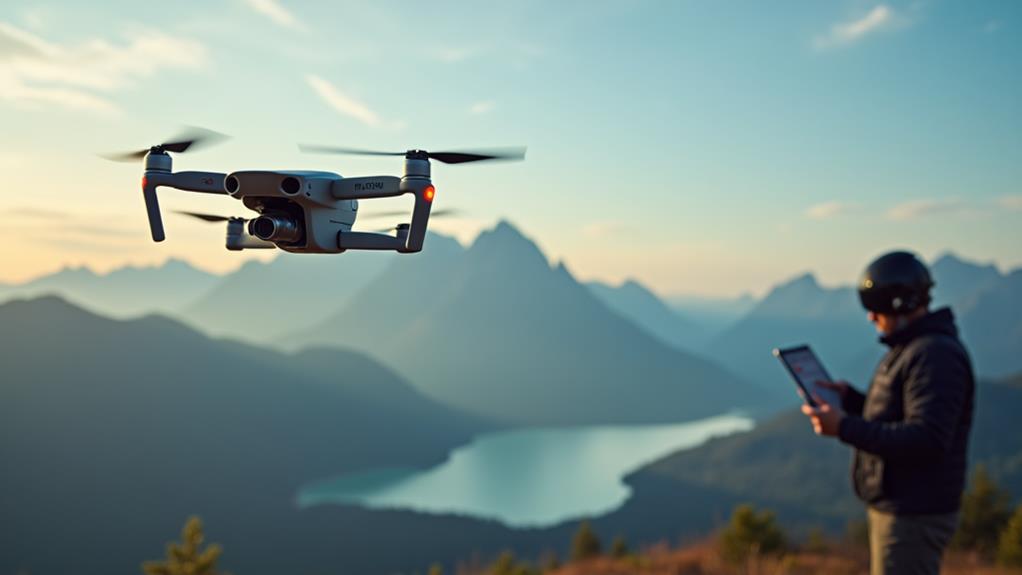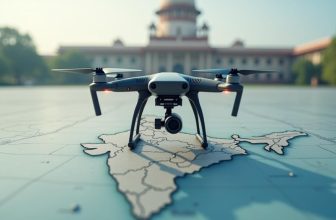
As you prepare to take to the skies with your drone in Canada, it's essential to understand the regulations that govern your flight. You'll need to know whether you're flying for recreational or commercial purposes, as this will determine the rules you must follow. For instance, if your drone weighs over 250g, you'll need to register it with Transport Canada – but that's just the tip of the iceberg. What other requirements will you need to meet to ensure you're flying safely and responsibly, and what are the consequences if you don't comply?
Contents
Key Takeaways
- Register drones weighing over 250g with Transport Canada, providing owner and drone details, and paying a $5 registration fee.
- Familiarize yourself with recreational drone regulations, including keeping drones in sight and respecting others' privacy.
- Obtain necessary licenses and certifications from Transport Canada for commercial drone operations, such as Basic or Advanced Operations.
- Identify and respect restricted airspaces in Canada, including airports, national parks, military bases, and correctional facilities.
- Implement safety precautions, such as effective flight planning, contingency plans, and thorough weather checks, to ensure compliant operation.
Drone Registration Requirements
In Canada, drone registration is mandatory if you plan on operating a remotely piloted aircraft system (RPAS) that weighs more than 250 grams and is used for recreational or commercial purposes.
You must register your drone with Transport Canada, the country's national transportation regulator, before you can operate it.
To begin the registration process, you'll need to visit the Transport Canada website and provide the required information, including your name, email address, and phone number.
You'll also need to provide details about your drone, such as its make, model, and serial number.
During the registration process, you'll be required to pay a registration fee, which currently stands at $5 per drone.
Once you've completed the registration process and paid the fee, you'll be issued a unique registration number that you must affix to your drone.
It's essential to ensure that your drone is registered and that you comply with all applicable regulations to avoid fines or penalties.
Recreational Drone Regulations
How do you guarantee compliance with Canada's recreational drone regulations?
First, verify your drone meets the required safety standards and weighs 250g or less, or between 250g and 25kg, and is registered if it's capable of being flown remotely.
Familiarize yourself with the Drone Registration Requirements, as outlined by Transport Canada. You must register your drone and mark it with the registration number if it weighs between 250g and 25kg.
Under Recreational Drone Regulations, you must always keep your drone in sight and respect the privacy of others.
Keep your drone at least 3 nautical miles away from airports and heliports, and never fly over or near emergency scenes or disaster areas.
Don't fly higher than 122 meters (400 feet) above ground level and avoid flying over or near military bases, national parks, or restricted areas.
Be aware of and respect all airspace restrictions.
Failure to comply with these regulations may result in fines of up to $5,000.
Always check the Transport Canada website for updates on recreational drone regulations before flying your drone.
Commercial Drone Licensing
Operating a drone for commercial purposes in Canada requires a more complex set of regulations than recreational use.
To guarantee compliance, you must obtain the necessary licenses and certifications from Transport Canada.
To begin, you must determine the type of drone operation you'll be conducting.
This will help you decide which license is required: the Basic or Advanced Operations license.
The Basic Operations license allows for drone usage in uncontrolled airspace, while the Advanced Operations license permits drone operation in controlled airspace.
Both licenses require you to pass a written exam and obtain liability insurance.
You must also guarantee that your drone meets the technical requirements outlined by Transport Canada, including being registered and marked with a unique identifier.
Additionally, you'll need to create a drone operations manual that outlines your company's policies and procedures for drone usage.
This manual must also include information on pilot training, maintenance, and emergency procedures.
Restricted Airspaces in Canada
Traversing Canada's airspace requires careful planning to avoid restricted areas.
As you prepare to fly your drone, it's essential to understand where you can and can't operate.
In Canada, there are various types of restricted airspaces that you need to be aware of.
These restrictions are in place to ensure public safety and prevent interference with other air traffic.
Some of the most common restricted airspaces include:
1. Airport restrictions: These are areas surrounding airports where drone operations are restricted or prohibited.
You must maintain a safe distance from airports to avoid interfering with manned aircraft.
2. National parks: Drone operations are restricted or prohibited in many national parks to protect wildlife and preserve the natural environment.
3. Military bases: These areas are restricted due to national security concerns, and drone operations are strictly prohibited.
4. Correctional facilities: Drone operations are restricted near correctional facilities to prevent the smuggling of contraband and maintain the safety of inmates and staff.
Safety Precautions and Guidelines
When flying a drone in Canada, it's essential to follow safety precautions and guidelines to minimize risks to people and property.
Effective flight planning is pivotal to guarantee a safe and compliant operation. You must assess the operational area and identify potential hazards, such as obstacles, wildlife, and people.
Develop a contingency plan for emergency situations, including system failures or loss of link.
Conduct thorough Weather Checks before and during flight to guarantee you're flying in suitable conditions.
Avoid flying in adverse weather, such as high winds, heavy precipitation, or low visibility. Verify your drone is airworthy and properly maintained.
Regularly inspect your drone for damage or wear and tear, and perform routine maintenance tasks as recommended by the manufacturer.
You must also maintain visual line-of-sight (VLOS) with your drone at all times and be aware of your surroundings.
Keep your drone away from people and animals, and respect private property.
Follow these safety precautions and guidelines to guarantee a safe and enjoyable drone flying experience in Canada.
Penalties for Non-Compliance
Non-compliance with Canada's drone regulations can lead to various penalties, including:
- Legal Fines: You may be liable for fines of up to $5,000 for individuals and up to $25,000 for corporations for contravening the Canadian Aviation Regulations (CARs) or the Aeronautics Act.
- Criminal Charges: In severe cases, you may face criminal charges, including imprisonment for up to six months, for offenses such as reckless operation or endangering the safety of aircraft or people.
- Revocation of Licenses: Your drone pilot certificate or SFOC (Special Flight Operations Certificate) may be revoked or suspended if you're found to be non-compliant with the regulations.
- Additional Administrative Penalties: You may also be required to pay additional administrative penalties, such as costs associated with investigation and enforcement.
It is vital to comply with Canada's drone regulations to avoid these penalties and guarantee safe and responsible drone operations.
Frequently Asked Questions
Can I Fly My Drone Over a Canadian National Park?
When flying your drone over a national park, you must comply with Park rules, which support Conservation efforts. Check with park authorities for specific regulations, and verify you're authorized before taking to the skies.
Are Drone Insurance Policies Mandatory in Canada?
You should consider drone insurance policies, although they aren't mandatory in Canada. You can explore drone coverage options, including liability policies, to protect yourself and others in case of accidents or damages while flying.
Can I Fly My Drone Near a Wildfire Operation Area?
When flames fuel chaos, you must prioritize fire safety. Avoid flying your drone near a wildfire operation area, as it can disrupt emergency response efforts and pose risks to responders and aircraft.
Do I Need a Drone License to Film a Wedding?
When filming a wedding, you'll likely need a drone license, as commercial use applies. Check with local authorities for specific Wedding Permits and Filming Regulations, which may require additional approvals and insurance coverage.
Can I Cross the Us-Canada Border With My Drone?
As you prepare for drone tourism, you'll encounter a different reality when crossing the US-Canada border. You must declare your drone to US and Canadian Border Patrol, following specific regulations to avoid confiscation or fines.
Conclusion
By following this step-by-step guide, you'll be well on your way to traversing Canada's complex drone laws. Don't let non-compliance be a ticking time bomb for your drone operations – register, obtain licenses, and familiarize yourself with restricted airspaces. Stay vigilant and adapt to changing regulations to avoid costly penalties. Effective compliance is the key to accessing a safe and successful drone flying experience in Canada.






